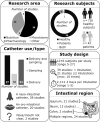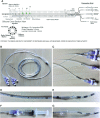Using naso- and oro-intestinal catheters in physiological research for intestinal delivery and sampling in vivo: practical and technical aspects to be considered
- PMID: 34036315
- PMCID: PMC8408849
- DOI: 10.1093/ajcn/nqab149
Using naso- and oro-intestinal catheters in physiological research for intestinal delivery and sampling in vivo: practical and technical aspects to be considered
Abstract
Intestinal catheters have been used for decades in human nutrition, physiology, pharmacokinetics, and gut microbiome research, facilitating the delivery of compounds directly into the intestinal lumen or the aspiration of intestinal fluids in human subjects. Such research provides insights about (local) dynamic metabolic and other intestinal luminal processes, but working with catheters might pose challenges to biomedical researchers and clinicians. Here, we provide an overview of practical and technical aspects of applying naso- and oro-intestinal catheters for delivery of compounds and sampling luminal fluids from the jejunum, ileum, and colon in vivo. The recent literature was extensively reviewed, and combined with experiences and insights we gained through our own clinical trials. We included 60 studies that involved a total of 720 healthy subjects and 42 patients. Most of the studies investigated multiple intestinal regions (24 studies), followed by studies investigating only the jejunum (21 studies), ileum (13 studies), or colon (2 studies). The ileum and colon used to be relatively inaccessible regions in vivo. Custom-made state-of-the-art catheters are available with numerous options for the design, such as multiple lumina, side holes, and inflatable balloons for catheter progression or isolation of intestinal segments. These allow for multiple controlled sampling and compound delivery options in different intestinal regions. Intestinal catheters were often used for delivery (23 studies), sampling (10 studies), or both (27 studies). Sampling speed decreased with increasing distance from the sampling syringe to the specific intestinal segment (i.e., speed highest in duodenum, lowest in ileum/colon). No serious adverse events were reported in the literature, and a dropout rate of around 10% was found for these types of studies. This review is highly relevant for researchers who are active in various research areas and want to expand their research with the use of intestinal catheters in humans in vivo.
Keywords: aspiration; colon; delivery; human; ileum; intestinal catheter; small intestine; trials.
© The Author(s) 2021. Published by Oxford University Press on behalf of the American Society for Nutrition.
Figures




Similar articles
-
Improved intestinal cannula for drug delivery studies in the dog.J Pharmacol Methods. 1988 May;19(3):213-7. doi: 10.1016/0160-5402(88)90023-x. J Pharmacol Methods. 1988. PMID: 3393004
-
Insulin-like growth factor and insulin receptors in intestinal mucosa of neonatal calves.J Endocrinol. 2003 Jan;176(1):121-32. doi: 10.1677/joe.0.1760121. J Endocrinol. 2003. PMID: 12525256
-
Differences in the acute response of the various segments ofrat intestine to treatment with the intestinal carcinogen, methylazoxymethanol acetate.Cancer Res. 1977 Jan;37(1):32-6. Cancer Res. 1977. PMID: 830418
-
Porcine Ex Vivo Intestinal Segment Model.In: Verhoeckx K, Cotter P, López-Expósito I, Kleiveland C, Lea T, Mackie A, Requena T, Swiatecka D, Wichers H, editors. The Impact of Food Bioactives on Health: in vitro and ex vivo models [Internet]. Cham (CH): Springer; 2015. Chapter 23. In: Verhoeckx K, Cotter P, López-Expósito I, Kleiveland C, Lea T, Mackie A, Requena T, Swiatecka D, Wichers H, editors. The Impact of Food Bioactives on Health: in vitro and ex vivo models [Internet]. Cham (CH): Springer; 2015. Chapter 23. PMID: 29787073 Free Books & Documents. Review.
-
Deflation of a Foley catheter balloon.Nurs Stand. 2003 Mar 19-25;17(27):33-8. doi: 10.7748/ns2003.03.17.27.33.c3360. Nurs Stand. 2003. PMID: 12683117 Review.
Cited by
-
(Wh)olistic (E)ndocannabinoidome-Microbiome-Axis Modulation through (N)utrition (WHEN) to Curb Obesity and Related Disorders.Lipids Health Dis. 2022 Jan 14;21(1):9. doi: 10.1186/s12944-021-01609-3. Lipids Health Dis. 2022. PMID: 35027074 Free PMC article. Review.
-
Gut microbiome and health: mechanistic insights.Gut. 2022 May;71(5):1020-1032. doi: 10.1136/gutjnl-2021-326789. Epub 2022 Feb 1. Gut. 2022. PMID: 35105664 Free PMC article. Review.
-
Acute effects of butyrate on intestinal permeability in patients with irritable bowel syndrome assessed by a novel colonoscopy research model.Gut Microbes. 2025 Dec;17(1):2545414. doi: 10.1080/19490976.2025.2545414. Epub 2025 Aug 14. Gut Microbes. 2025. PMID: 40810534 Free PMC article.
-
Detailed Analysis of Prebiotic Fructo- and Galacto-Oligosaccharides in the Human Small Intestine.J Agric Food Chem. 2024 Sep 25;72(38):21152-21165. doi: 10.1021/acs.jafc.4c03881. Epub 2024 Sep 16. J Agric Food Chem. 2024. PMID: 39282870 Free PMC article.
-
How to Study the Effects of Dietary Lipids on the Small Intestinal Microbiome? Methodological Design and Evaluation of the Human HealThy fAt, haPpy mIcRobiome (TAPIR) Proof-of-Concept Study.Curr Dev Nutr. 2025 Feb 5;9(3):104564. doi: 10.1016/j.cdnut.2025.104564. eCollection 2025 Mar. Curr Dev Nutr. 2025. PMID: 40092654 Free PMC article.
References
-
- Nagy K, Ramos L, Courtet-Compondu MC, Braga-Lagache S, Redeuil K, Lobo B, Azpiroz F, Malagelada JR, Beaumont M, Moulin Jet al. . Double-balloon jejunal perfusion to compare absorption of vitamin E and vitamin E acetate in healthy volunteers under maldigestion conditions. Eur J Clin Nutr. 2013;67(2):202–6. - PubMed
-
- Luttikhold J, van Norren K, Buijs N, Ankersmit M, Heijboer AC, Gootjes J, Rijna H, van Leeuwen PA, van Loon LJ. Jejunal casein feeding is followed by more rapid protein digestion and amino acid absorption when compared with gastric feeding in healthy young men. J Nutr. 2015;145(9):2033–8. - PubMed
-
- Strocchi A, Levitt MD. Measurement of starch absorption in humans. Can J Physiol Pharmacol. 1991;69(1):108–10. - PubMed
-
- Hecketsweiler P, Vidon N, Emonts P, Bernier JJ. Absorption of elemental and complex nutritional solutions during a continuous jejunal perfusion in man. Digestion. 1979;19(3):213–7. - PubMed
Publication types
MeSH terms
LinkOut - more resources
Full Text Sources
Other Literature Sources

